Bertille Bak
07.02.2018 – 06.04.2018
Exhibition Views
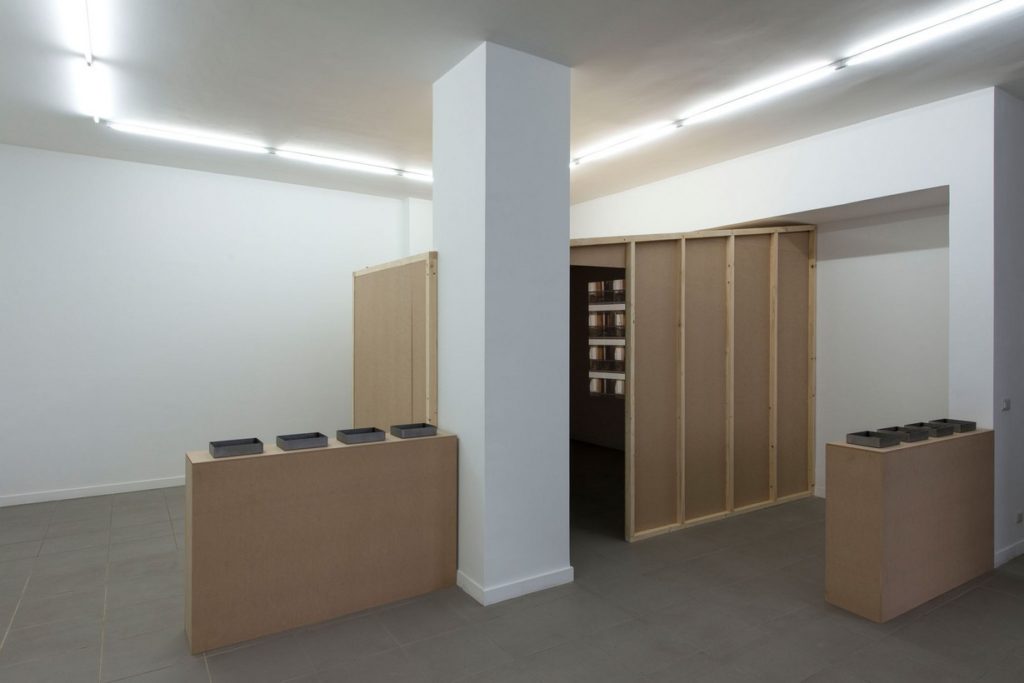
ALL INCLUSIVE VIAGGIO, installation view (ground floor), photo Giorgio Benni 
ALL INCLUSIVE VIAGGIO, installation view (ground floor), photo Giorgio Benni 
Le tour de Babel, 2014, video 16:9 stereo, 22 min, ed. 5+1AP, production Le Grand Café_ centre d’art contemporain_ Saint-Nazaire, installation view, photo Giorgio Benni 
ALL INCLUSIVE VIAGGIO, installation view (ground floor), photo Giorgio Benni 
ALL INCLUSIVE VIAGGIO, installation view (ground floor), photo Giorgio Benni 
Les Complaisants, 2014, hair inlays, metal frames, unique + 1AP, 17,5 x 22,5 x 5 cm (framed), installation view, photo Giorgio Benni 
Les Complaisants, 2014, hair inlays, metal frames, unique + 1AP, 17,5 x 22,5 x 5 cm (framed), installation view, photo Giorgio Benni 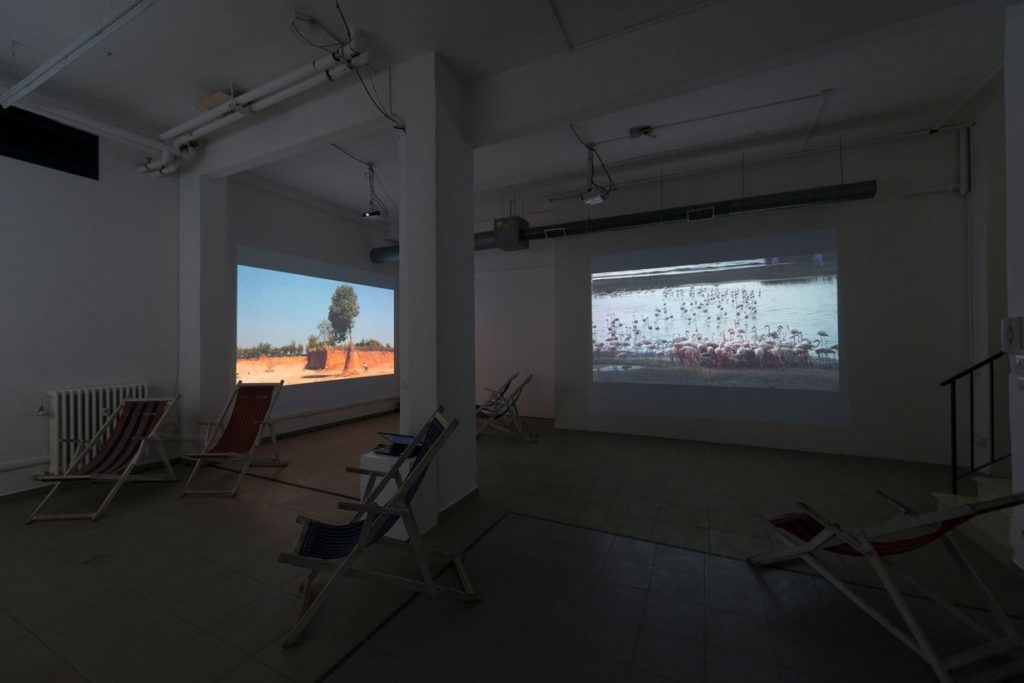
Usine à divertissement, 2016, video trilogy, 20 min, ed. 6+1AP, production for BIM Genève 2016, installation view (basement), photo Giorgio Benni 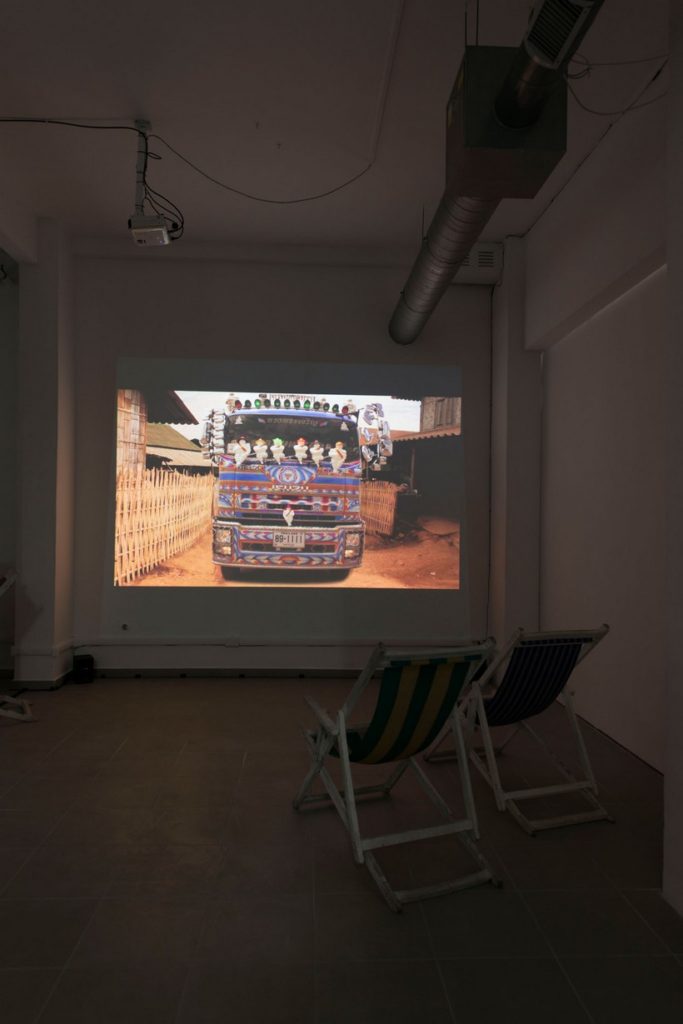
Usine à divertissement, 2016, video trilogy, 20 min, ed. 6+1AP, production for BIM Genève 2016, installation view (basement), photo Giorgio Benni 
Usine à divertissement, 2016, video trilogy, 20 min, ed. 6+1AP, production for BIM Genève 2016, installation view (basement), photo Giorgio Benni 
ALL INCLUSIVE VIAGGIO, installation view (ground floor), photo Giorgio Benni 
La marée mise à nu par ses célibataires, même, 2014, in collaboration with Charles-Henry Fertin, electromechanical packages, glossy paper prints, 11 x 16 cm, unique, installation view, photo Giorgio Benni 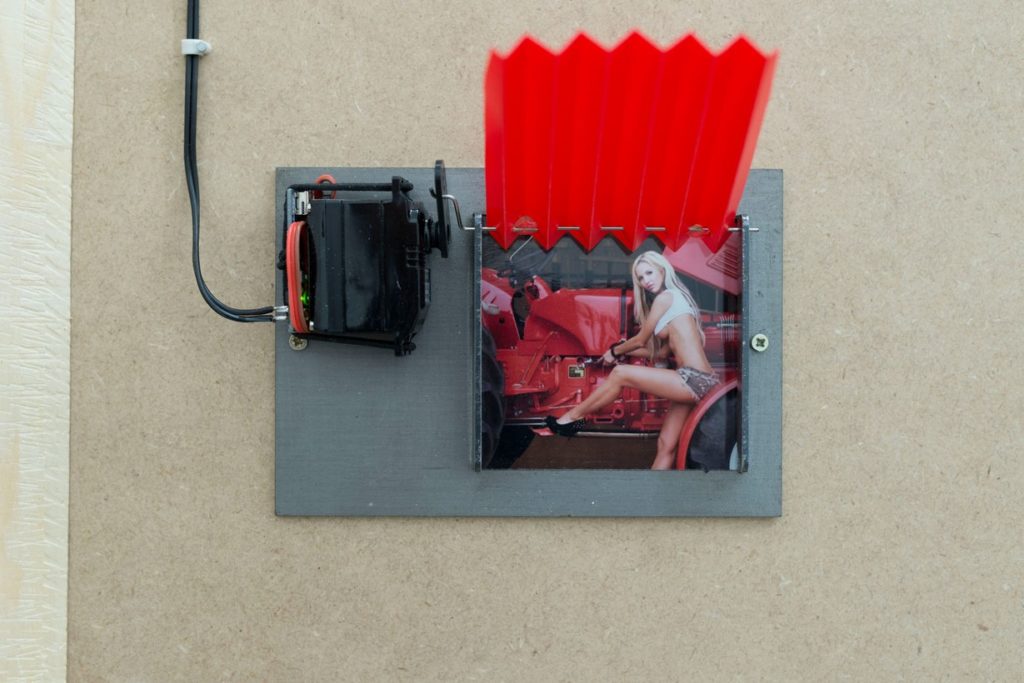
La marée mise à nu par ses célibataires, même, 2014, in collaboration with Charles-Henry Fertin, electromechanical packages, glossy paper prints, 11 x 16 cm, unique, photo Giorgio Benni
Works
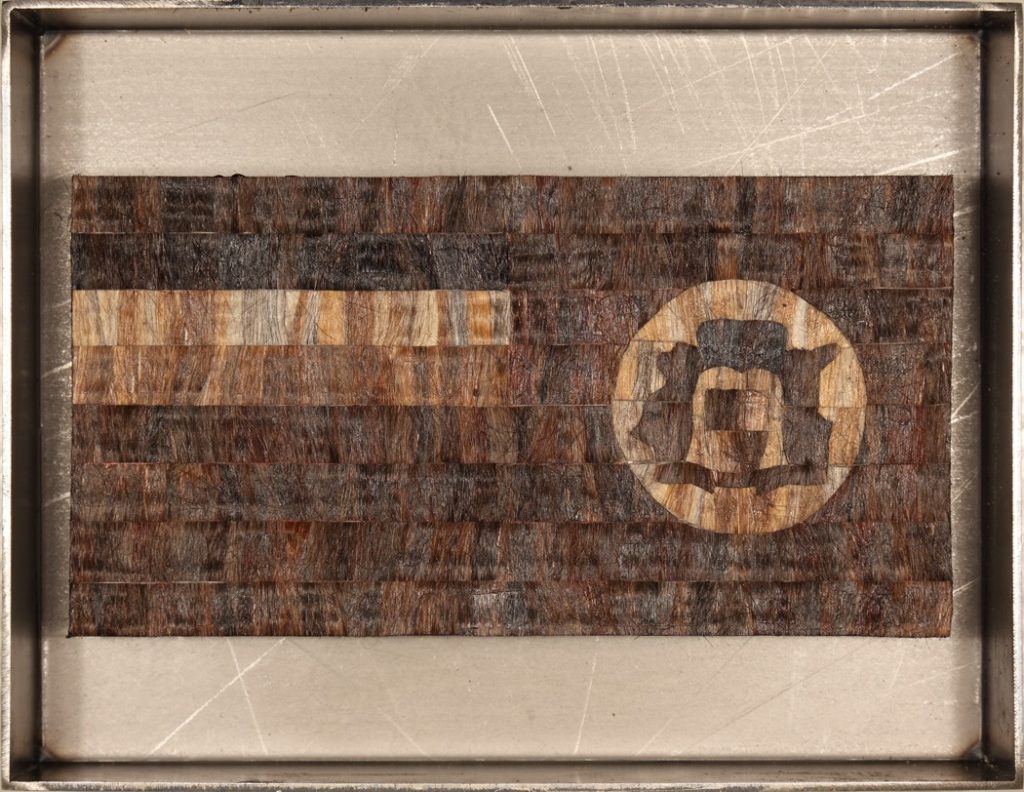
Complaisant 27 (Maurice), 2014, hair inlays, metal frames, unique + 1AP, 17,5 x 22,5 x 5 cm (framed) 
Complaisant 1 (Antigua-et-Barbuda), 2014, hair inlays, metal frames, unique + 1AP, 17,5 x 22,5 x 5 cm (framed) 
Complaisant 2 (Antilles néerlandaises), 2014, hair inlays, metal frames, unique + 1AP, 17,5 x 22,5 x 5 cm (framed) 
Complaisant 25 (Malte), 2014, hair inlays, metal frames, unique + 1AP, 17,5 x 22,5 x 5 cm (framed) 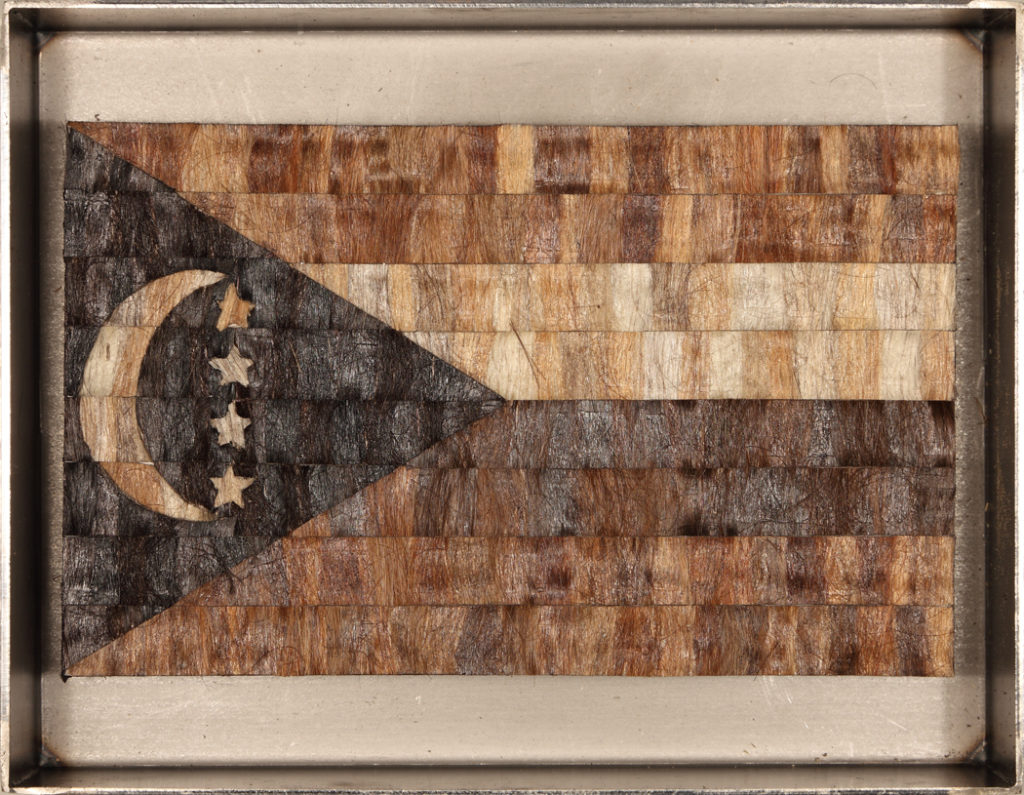
Complaisant 12 (Comores), 2014, hair inlays, metal frames, unique + 1AP, 17,5 x 22,5 x 5 cm (framed) 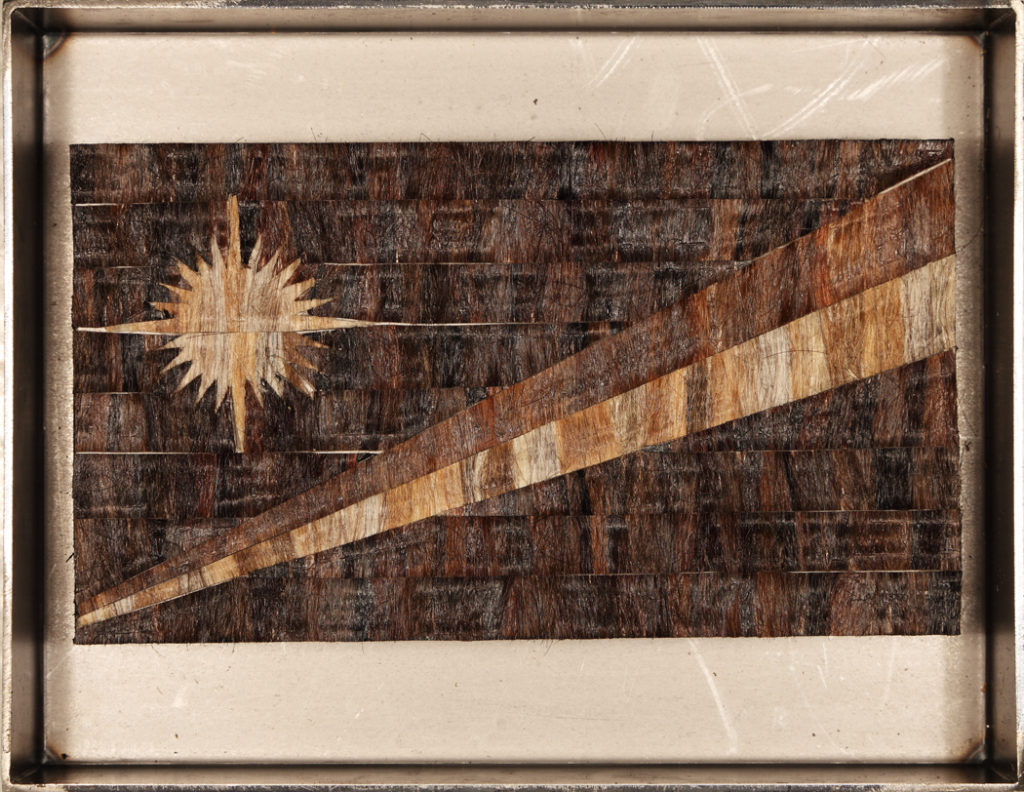
Complaisant 26 (Iles Marshall), 2014, hair inlays, metal frames, unique + 1AP, 17,5 x 22,5 x 5 cm (framed) 
Figures imposées, 2015, video 16:9 stereo, 16 min, ed. 1/1 + 2 AP, realized within the project “Nouveaux Commanditaires” 
Le tour de Babel, 2014, video 16:9 stereo, 22 min, ed. 5+1AP, production Le Grand Café_ centre d’art contemporain_ Saint-Nazaire 
Le tour de Babel, 2014, video 16:9 stereo, 22 min, ed. 5+1AP, production Le Grand Café_ centre d’art contemporain_ Saint-Nazaire 
Usine à divertissement, 2016, video trilogy, 20 min, ed. 6+1AP, production for BIM Genève 2016 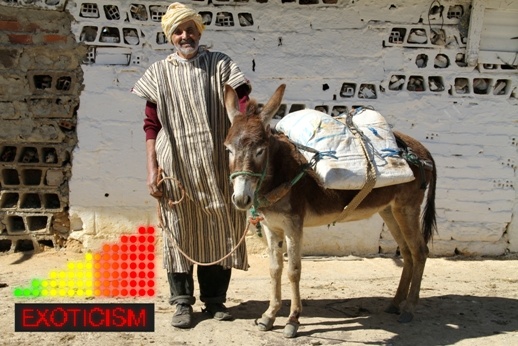
Usine à divertissement, 2016, video trilogy, 20 min, ed. 6+1AP, production for BIM Genève 2016 
Usine à divertissement, 2016, video trilogy, 20 min, ed. 6+1AP, production for BIM Genève 2016 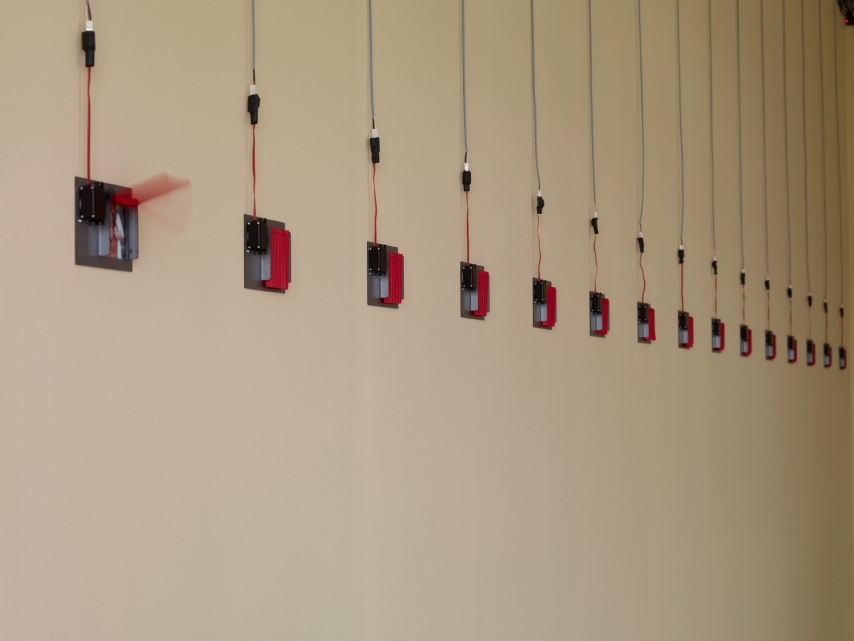
La marée mise à nu par ses célibataires, même, 2014, installation view, in collaboration with Charles-Henry Fertin, electromechanical packages, glossy paper prints, 11 x 16 cm, unique 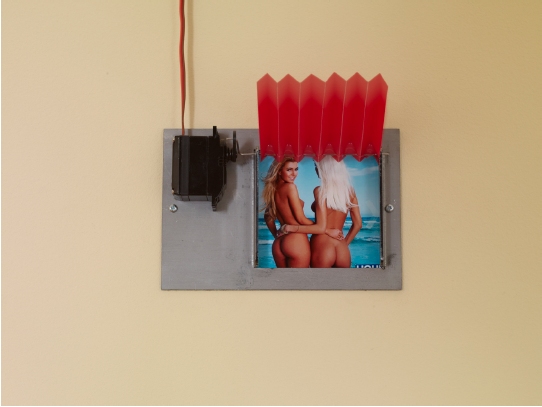
La marée mise à nu par ses célibataires, même, 2014, in collaboration with Charles-Henry Fertin, electromechanical package, glossy paper print, 11 x 16 cm, unique 
La marée mise à nu par ses célibataires, même, 2014, in collaboration with Charles-Henry Fertin, electromechanical package, glossy paper print, 11 x 16 cm, unique
The Gallery Apart is proud to present ALL INCLUSIVE VIAGGIO, the second solo exhibition by Bertille Bak in the gallery spaces. Following a year full of significant events for the artist, among which are the Biennial of Moving Image at the Centre d’Art Contemporain in Geneva, which closed last January 2017, documenta 14 in Kassel, and the recent monographic stand during Artissima in the Present Future section, the artist will be carrying on in Rome the thread started with the previous exhibit Radice, setting up an exhibition project that revolves around the idea of the journey. The title of the exhibit ALL INCLUSIVE VIAGGIO also highlights two characteristics of the artist’s work: on the one hand, the selection of a theme for its implications and potential for a social analysis that Bak develops as she becomes interested in those people who every day share stories and cultures, with a view to understanding their world and representing it through the tools offered by art itself; on the other hand, the search for utopia, irony, lightness and the sense of humour that characterize her art-making process and that push it to go beyond the simple social observation.
ALL INCLUSIVE VIAGGIO brings together various works by Bak, which revolve around the concept of journey in all its possible facets, gathering even antithetic traits, dealing with fields at times more intimate and other times more social, from entertainment, to escape, to the pursuit of happiness or more often to the chance to save one’s own life, to the effects of mass tourism, to ecology, to the sustainable development in the poorest Countries. The videos and the sculptural works featuring in the exhibition blend documentary and fiction, leaving the viewer as in a limbo, surrounded by very realistic scenarios anchored to some of the most critical issues currently confronting humanity (such as, the persecutions and trafficking in human beings, the right of asylum, the exploitation of territories) and, at the same time, too absurd to be real. Thus, the artist goes beyond the documentary and calls on the viewer, soothing them with the weapon of irony, to make an effort to understand reality.
Usine à divertissement, the video trilogy conceived for Geneva’s Biennale, lampoons the forms and the effects of ‘predatory’ tourism in constant search for exoticism. Shot in a village in the North of Thailand inhabited by the Lahu tribe, in the Rif mountains in North Morocco and finally in the Camargue region, France, the work deals with the cynical ways of operations of the tourism industry aimed at serving the growing demand for experiences related to exotic ethnicities. The latter are therefore increasingly forced to turn their lifestyle habits into a show and social organizations which become a sort of money-making simulacrum and rites. A new organization totally devoid of any ethics and which shows total disregard for human rights and the territories.
Likewise, the video Le tour de Babel and the works featuring the installation Les complaisants explore the idea of journey based on the evocations from the navigation, from the ways and the people who carry out activities related to the sea. During a residency in Saint-Nazaire, a transit port for large merchant vessels, Bak was employed at a Sea-men’s club in order to be in close contact with the workers disembarked from the vessels. Thus, the artist could meet hundreds of seafarers and know a world made of rituals and traditions, of loneliness and exploitation. Drawing on a practice narrated by the seafarers themselves, who use their own hair to create marquetry works as a pastime, Bak collected locks of hair from the seamen she met to create a series of marquetry works representing flags of convenience, that is the flags of the nations where ship owners register their merchant ships, different from their home country. An option granted to ship owners which allows practices of tax evasion and minor obligations regarding the working conditions of the crew members.
The video Le tour de Babel focuses on the cruise industry, highlighting, on the one hand, the structural arsenal designed for the entertainment of the cruise passengers, on the other hand, the specific nature of the shipbuilding industry dedicated to giantism and the exploitation of the workers, both in the building sites and on the ships.
La marée mise à nu par ses célibataires, même – a work realized in collaboration with Charles-Henry Fertin which is also related to the seafarers’ life – shares with Duchamp’s masterpiece the reference to eroticism, that Duchamp wanted to introduce through The Large Glass and that in the work by Bak evokes a condition of sexual and sentimental isolation that the seafarers try to elude through the pictures of naked women to give them fleeting moments of pleasure. Under the small curtains, for a brief moment, the naked silhouettes of the women garnishing the cabins of the seafarers met by the artist are uncovered.
A further and even more caustic reference to the journey is found finally in the video Figures imposées dedicated to the condition of the migrants and of the asylum seekers without a passport. The work was commissioned by the Maison des Femmes du Hédas, in the Pau District, which works for the integration of the immigrant women. In the light of their life experiences, the artist has involved them in a series of projects aimed at highlighting the hiding ability necessary to those who want to cross illegally the border. In an allegorical and ironical way, the video underlines the inhuman conditions to which migrants are forced, the possibilities of hideaway offered by the largest vessels, the inadequacy of the migrations policies of the Western countries that, making these ‘voyages to a better life’ even harder, actually allow human traffickers to ask for more money and to increase their business volume at the expense of the desperate people to whom they sell illusions.
The Gallery Apart è orgogliosa di presentare ALL INCLUSIVE VIAGGIO, la seconda personale di Bertille Bak in galleria. All’indomani di un anno ricco di appuntamenti significativi per l’artista, tra i quali spiccano la Biennale dell’Immagine in Movimento al Centre d’Art Contemporain di Ginevra conclusasi a gennaio del 2017, documenta 14 a Kassel e il recente stand monografico ad Artissima nella sezione Present Future, l’artista prosegue a Roma il filo del discorso avviato con la precedente mostra Radice, costruendo un progetto espositivo articolato intorno all’idea di viaggio. Già il titolo ALL INCLUSIVE VIAGGIO evidenzia due caratteristiche del lavoro dell’artista: da un lato la scelta di un tema per i suoi risvolti e le sue potenzialità di analisi sociale che Bak sviluppa interessandosi a persone che condividono quotidianamente storie e culture con l’intento di comprendere insieme a la loro realtà e di rappresentarla attraverso gli strumenti offerti dall’arte; dall’altro la ricerca dell’utopia, l’ironia, la leggerezza e il senso dell’umorismo che caratterizzano il suo procedere artistico e che la spingono ad andare oltre la semplice osservazione sociale.
ALL INCLUSIVE VIAGGIO raccoglie diversi lavori che Bak ha realizzato intorno al concetto di viaggio inteso in tutte le sue possibili accezioni, cogliendo risvolti persino antitetici, attraversando campi a volte più intimi altre volte più sociali, dal divertimento, all’evasione, alla fuga, alla ricerca della felicità o più spesso alla possibilità di salvarsi la vita, fino agli effetti del turismo di massa, all’ecologia, allo sviluppo sostenibile in Paesi poverissimi. Le opere video e le sculture proposte in mostra si situano al crocevia tra documentazione e finzione, lasciando lo spettatore in un limbo, attorniato da scenari troppo realistici per non essere ancorati a questioni vere che attanagliano l’umanità (le persecuzioni e il traffico di esseri umani, il diritto d’asilo, lo sfruttamento dei territori) e nel contempo troppo assurdi per essere veri. Facendo ciò, l’artista travalica il limite del documentarismo e chiama lo spettatore, blandendolo con l’arma dell’ironia, ad uno sforzo di comprensione della realtà.
Usine à divertissement, la trilogia video realizzata per la Biennale ginevrina, ironizza su modalità ed effetti del turismo predatorio alla costante ricerca di esotismo. Girata in un villaggio nel Nord della Thailandia abitato dal popolo Lahu, nelle montagne del Rif nel Nord del Marocco e infine nella regione francese della Camargue, l’opera è incentrata sulle ciniche modalità di esercizio di un’industria turistica volta a soddisfare la crescente richiesta di esperienze legate ad etnie esotiche. Queste sono sempre più costrette a spettacolarizzare abitudini di vita e organizzazioni sociali che in tal modo diventano simulacri e riti di stampo commerciale. Una nuova organizzazione totalmente priva di etica e irrispettosa dei diritti umani e dei territori.
Analogamente, il video Le tour de Babel e i lavori che compongono l’installazione Les complaisants declinano il concetto di viaggio in base a suggestioni provenienti dall’idea di navigazione, dai modi e dalle persone che svolgono attività legate al mare. Nel corso di una residenza a Saint-Nazaire, porto di transito di grandi navi commerciali, Bak si è fatta assumere presso un Sea-men’s club per poter essere in stretto contatto con i lavoratori sbarcati dalle navi. L’artista ha così potuto incontrare centinaia di marinai e conoscere un mondo fatto di riti e tradizioni, di solitudine e di sfruttamento. Riprendendo una pratica narrata dagli stessi marinai, che utilizzano i loro capelli per realizzare come passatempo dei lavori ad intarsio, Bak ha raccolto ciocche di capelli dei marinai incontrati ed ha realizzato una serie di opere ad intarsio raffiguranti bandiere di convenienza, o di comodo, vale a dire le bandiere delle nazioni dove le imbarcazioni sono immatricolate, diverse da quelle della nazionalità dei proprietari. Una facilitazione concessa agli amatori che consente pratiche di evasione fiscale e minori obblighi riguardanti le condizioni di lavoro dell’equipaggio.
Il video Le tour de Babel si concentra invece sull’industria crocieristica, evidenziando da un lato tutto l’armamentario strutturale finalizzato all’evasione dei crocieristi, veri e propri consumatori di viaggi, dall’altro le specificità di un’industria cantieristica vocata al gigantismo e lo sfruttamento dei lavoratori tanto nei cantieri quanto sulle navi.
Sempre legato alla vita in mare dei marinai è il lavoro La marée mise à nu par ses célibataires, même, opera realizzata in collaborazione con Charles-Henry Fertin e che condivide con il capolavoro duchampiano il riferimento all’erotismo, che Duchamp voleva introdurre attraverso il suo Grande Vetro e che nell’opera di Bak richiama una condizione di isolamento erotico e sentimentale che i marinai tentano di aggirare attraverso immagini di donne nude capaci di assicurare fugaci momenti di piacere. Sotto piccole tende vengono svelate per un istante le nude sagome di donne che adornano le cabine dei marinai incontrati.
Un ulteriore e ancora più caustico riferimento al viaggio si riscontra infine nel video Figures imposées dedicato alla condizione dei migranti e richiedenti asilo senza documenti. L’opera consegue ad una commissione della Maison des Femmes du Hédas, nel Distretto di Pau, che lavora per l’integrazione nella città delle donne immigrate. Alla luce delle loro stesse esperienze di vita, l’artista le ha coinvolte in una serie di azioni volte ad esaltare le capacità di mimetismo necessarie a chi intenda varcare illegalmente una frontiera. In maniera allegorica ed ironica, il video sottolinea le condizioni inumane cui sono soggetti i migranti, le possibilità di nascondiglio offerte dai mezzi di trasporto sempre più grandi, l’inadeguatezza delle politiche migratorie dei Paesi occidentali che, rendendo più difficili i viaggi della speranza, di fatto consentono a trafficanti di uomini senza scrupoli di alzare le loro richieste e il loro volume d’affari a discapito dei disperati a cui vendono le loro illusioni.
The Gallery Apart est fière de présenter ALL INCLUSIVE VIAGGIO, la deuxième exposition personnelle de Bertille Bak en galerie. Après une année riche en évenements marquants, tels que la Biennale de l’Image en Mouvement au Centre d’Art Contemporain de Genève, la Documenta 14 à Kassel et le stand monographique à Artissima dans la section Present Future (Turin), l’artiste poursuit à Rome la réflexion entamée lors de sa précédente exposition, Radice. Elle conçoit un projet d’exposition articulé autour du concept de voyage. Le titre, ALL INCLUSIVE VIAGGIO met en évidence deux des caractéristiques du travail de l’artiste : d’un côté le choix d’un thème pour son impact et ses potentialités d’analyse sociale, car Bak s’intéresse aux personnes qui partagent un quotidien des histoires et une culture commune, pour ensuite appréhender avec eux leur réalité et la représenter à travers les outils offerts par l’art; de l’autre côté, il y a la recherche de l’utopie, l’ironie, la légèreté et le sens de l’humour qui caractérisent son approche artistique et la poussent à dépasser la simple observation sociale.
ALL INCLUSIVE VIAGGIO rassemble divers travaux réalisés par Bertille Bak autour du concept du voyage entendu dans toutes ses acceptions possibles. Elle va jusqu’à saisir ses aspects les plus antinomiques, en traversant des champs tantôt intimes, tantôt plus sociaux, on passe du divertissement, de la fuite, de la recherche du bonheur à la possibilité d’y laisser sa propre vie jusqu’aux effets du tourisme de masse, de l’écologie, du développement durable dans les pays très pauvres. Les œuvres vidéo et les sculptures proposées dans cette exposition se situent au carrefour entre documentaire et fiction, et laissent le spectateur dans un entre-deux; il est alors entouré de décors trop réalistes pour ne pas être enracinés dans des problèmes qui tourmentent l’humanité (les persécutions et la traite des êtres humains, le droit d’asile, l’exploitation des territoires) et en même temps trop absurdes pour être vrais. Ce faisant, l’artiste franchit la limite de l’approche documentaire et convie le spectateur, en le flattant par l’arme de l’ironie, à un effort de compréhension de la réalité.
Usine à divertissement, la trilogie vidéo réalisée pour la Biennale genevoise, ironise sur les modalités et les effets du tourisme prédateur, en quête permanente d’exotisme. Tournée dans un village du nord de la Thaïlande, où vit le peuple Lahu, ainsi que dans les montagnes du Rif au nord du Maroc et enfin dans la région française de la Camargue, cette œuvre se focalise sur les procédés cyniques de l’industrie touristique qui s’adonne à satisfaire la recherche croissante d’expériences liées à des ethnies exotiques. De plus en plus, celles-ci se retrouvent obligées de mettre en scène leurs coutumes et leurs organisations sociales par des simulacres et des rites de nature commerciale. Une nouvelle organisation totalement privée d’éthique et irrespectueuse des droits humains et des territoires.
De même, la vidéo Le tour de Babel et les travaux qui composent l’installation Les complaisants déclinent le concept de voyage sur la base de l’idée de navigation, des moyens et des personnes qui exercent des activités liées à la mer. Au cours d’une résidence à Saint-Nazaire, port de transit de grands navires commerciaux, Bak s’est fait embaucher dans un Sea men’s club afin d’entrer en contact étroit avec les travailleurs fraîchement débarqués des bateaux. L’artiste a ainsi pu rencontrer des centaines de marins et connaître un monde fait de rites et de traditions, de solitudes et d’exploitation. Reprenant une pratique racontée par les marins eux-mêmes, qui utilisaient jadis leur chevelure comme passe-temps pour réaliser des marqueteries, Bak a recueilli auprès d’eux des mèches de cheveux pour réaliser la série Les complaisants. Ceux-ci représentent des pavillons de complaisance, c’est-à-dire les drapeaux des nations où sont immatriculés les bateaux, différents de ceux des nationalités des propriétaires. Cette facilité accordée aux armateurs permet l’évasion fiscale et une plus grande légèreté concernant les conditions de travail de l’équipage.
La vidéo Le tour de Babel se focalise sur l’industrie des croisières, avec d’un côté toute la panoplie structurelle destinée à l’évasion pour croisiéristes, véritables consommateurs de voyages; d’un autre côté les spécificités d’une industrie navale vouée au gigantisme ainsi que l’exploitation des travailleurs en vigueur aussi bien sur les chantiers que sur les bateaux.
Toujours en lien avec la vie des marins, le travail La marée mise à nu par ses célibataires, même, œuvre réalisée en collaboration avec Charles-Henry Fertin, partage avec le chef-d’œuvre de Duchamp la référence à l’érotisme, que Duchamp voulait introduire à travers son Grand Verre. Dans l’œuvre est rappelée la condition d’isolement érotique et sentimental que les marins essaient de contourner à travers les images de femmes nues, qui leur assurent de fugaces moments de plaisir. Sous des petits rideaux se dévoilent subrepticement les silhouettes dénudées des femmes ornant les cabines des marins rencontrés.
Une dernière référence au voyage, encore plus caustique, est visible dans la vidéo Figures imposées dédiée à la condition des migrants et demandeurs d’asile sans papiers. La pièce émane d’une demande de la Maison des Femmes du Hédas, dans la commune de Pau, qui aide à l’épanouissement dans la cité des femmes immigrées. D’après leurs propres récits de vie, elle les a engagées dans une série d’actions destinées à exalter les capacités de mimétisme nécessaires à celui qui veut franchir illégalement une frontière. De manière allégorique et ironique, la vidéo souligne les conditions inhumaines auxquelles sont soumis les migrants, les possibilités de cachette offertes par les moyens de transport de plus en plus grands, et l’inadéquation des politiques migratoires des pays occidentaux. En effet, ceux-ci, en rendant plus difficiles les voyages de l’espoir, donnent la possibilité aux trafiquants d’êtres humains sans scrupules de redoubler leurs exigences et leurs volumes d’affaires au mépris des désespérés auxquels ils vendent leurs illusions.
share on